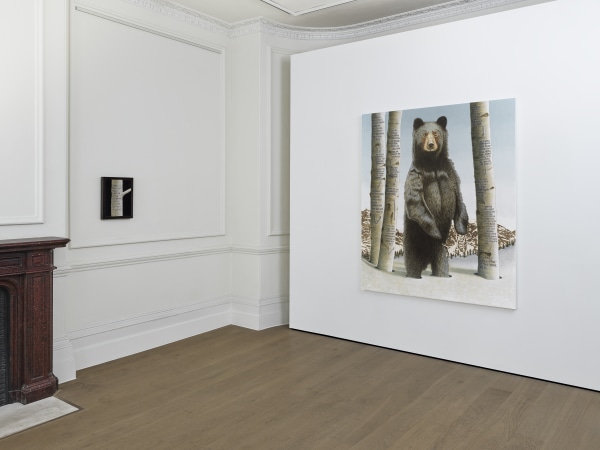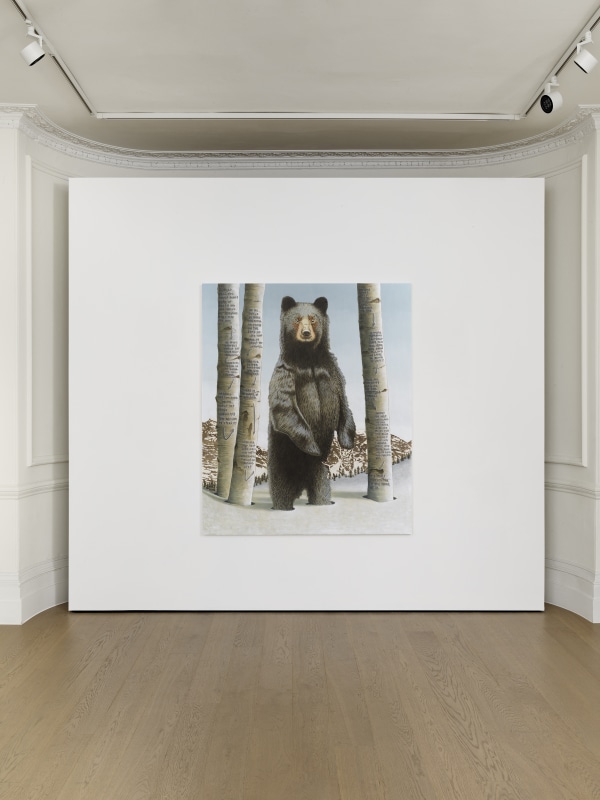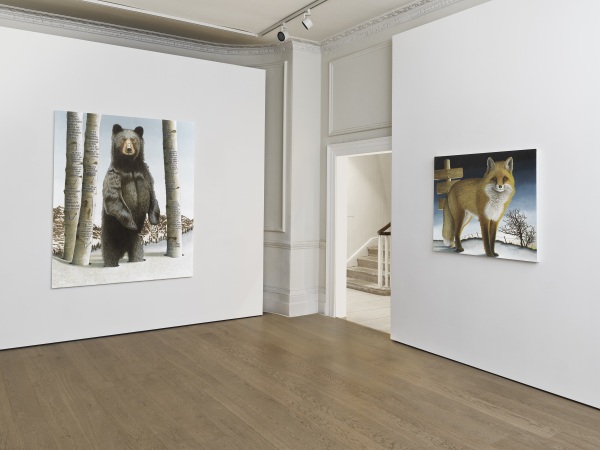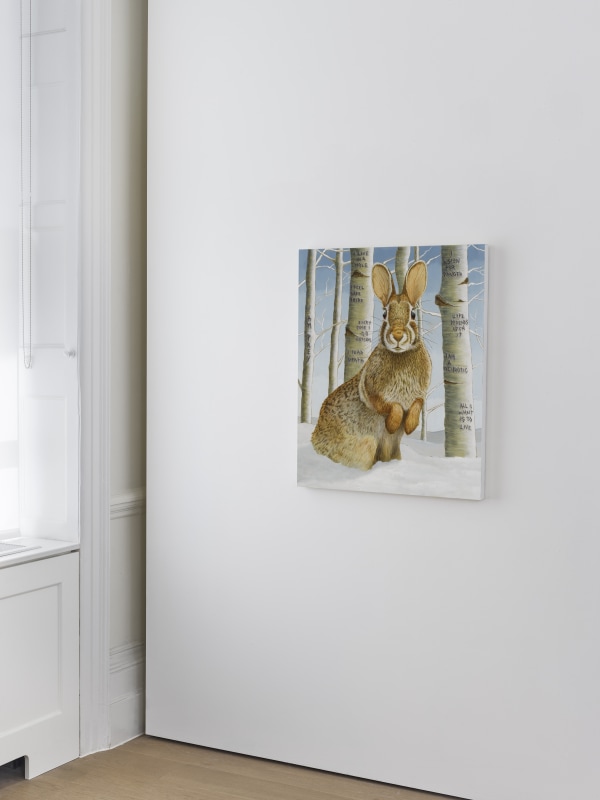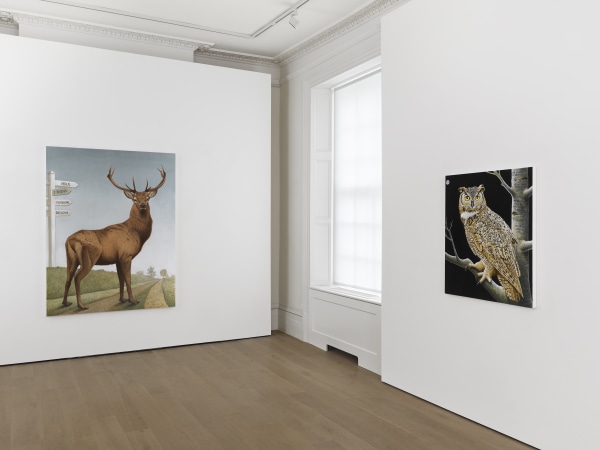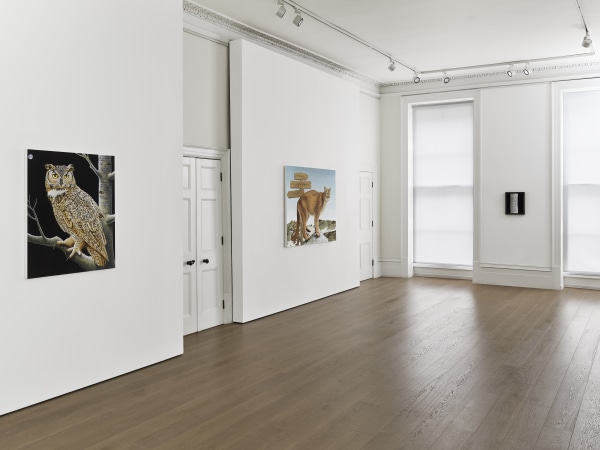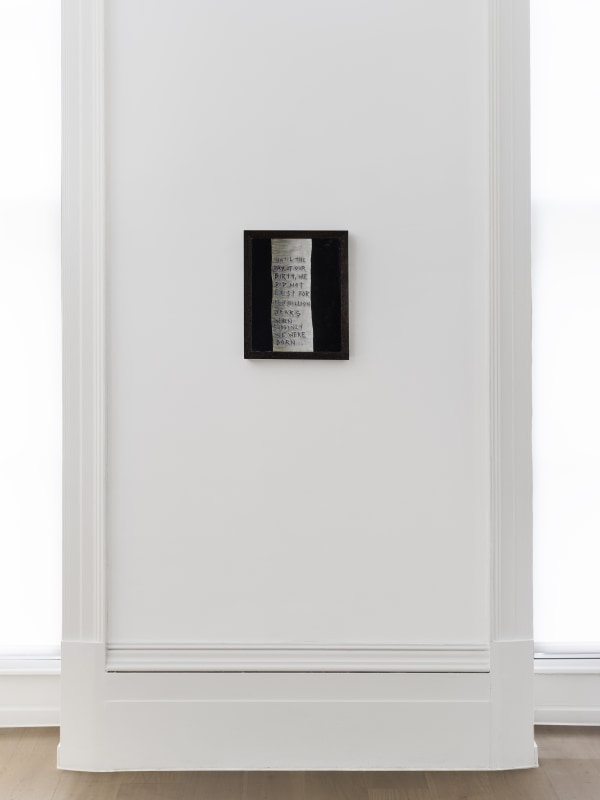Sean Landers: Animal Portraits
-
Overview
Timothy Taylor is pleased to present Animal Portraits, an exhibition in London of new paintings by Sean Landers. The artist's debut presentation with the gallery since the announcement of his representation in 2023 will feature eight canvases from a new series of animal portraits, in addition to two intimately scaled tree paintings. These works reflect his evolving relationship to the many dimensions of making art.
In his recent paintings, Landers surrounds wild animals, many of them native to the UK, with texts revealing the artist's sense of existential awareness. Rendered with sharp, careful detail, his creatures-a grey wolf, a red fox, a cougar-gaze back at the viewer or look knowingly beyond them. Each animal stands within an idyllic landscape punctuated by vernacular signposts or aspen trees bearing telling inscriptions. In Its Own Reward (Great Horned Owl) (all paintings 2024), an exquisite horned owl perches on the branch of a tree where a series of texts has been carved. "We exist so briefly…the privilege of life is its own reward." For Landers, this painting reflects his state of mind in the current moment; reflecting on the dynamics of his more than thirty-year career, he finds deep pleasure in the process of painting with virtuosity and without posturing.
Elsewhere, he mirrors aspects of earlier stages in his creative life. To Live (Cottontail Rabbit) depicts a rabbit in a wintry scene, its ears perked in high alert. Inscribed in the aspen trees behind the creature are brief, chaotic thoughts: "I am prey…I listen for danger…All I want is to live." Here, the artist considers his artistic youth, a period spent seeking novelty and rebellion while also harbouring anxieties about his creative path. A painting of otters in a marsh alludes to the artist's state of mind midcareer; the slick mammals attend a signpost that directs the viewer toward "Cynicism," "Irony," and "Cuteness."
For Landers, the aspen tree holds symbolic significance. Aspens grow in colonies along rhizomatic, long-living systems, meaning that all trees in a given area are interconnected. Landers considers this an apt analogy for his work; though his practice has evolved over the years, which has resulted in seemingly disparate approaches to painting and sculpture, there are resilient conceptual and methodological throughlines that connect each body of work. Text for example, a constant in his work, has appeared in his paintings since the early 1990s, when his diaristic paintings of black-and-white automatic writing were instrumental in defining the art landscape of the moment. More recently, he transformed these earlier anxieties into sincerity and genuineness.
In Truly Wonderful (Black Bear), a black bear stands sentry among a copse of aspens. The trees are inscribed with the following passage, which, as Landers explains, summarises the essence of this exhibition:
I could tell you about Sean's fear of death and how making art assuages that fear for him, or his sadness about the seeming meaninglessness of life in an uncaring universe. He could say something poetic about art being humanity's sad answer to eternity, or he could be more cheerful and focus on the joys of life that are in great abundance. This is a better function and use for art. There is no shame in smiling. Whoever said that happiness was not a worthwhile pursuit of art and life? And how about love? Love is a wonderful subject for art. Is there anything that could make you feel more alive than falling in love or being in love? These are the gifts of life and the incredible miracle of it. Amidst the vast wasteland of the universe here we are on our tiny blue planet drifting through space and time falling in love and making art. It is truly wonderful if you think of it.
-
Works
-
 Sean LandersCuteness (River Otters)2024Oil on linen42 x 36 in. (106.7 x 91.4 cm)
Sean LandersCuteness (River Otters)2024Oil on linen42 x 36 in. (106.7 x 91.4 cm) -
 Sean LandersNo, No, No (Red Fox)2024Oil on linen36 x 42 in. (91.4 x 106.7 cm)
Sean LandersNo, No, No (Red Fox)2024Oil on linen36 x 42 in. (91.4 x 106.7 cm) -
 Sean LandersTo Live (Cottontail Rabbit)2024Oil on linen34 x 28 in. (86.4 x 71.1 cm)
Sean LandersTo Live (Cottontail Rabbit)2024Oil on linen34 x 28 in. (86.4 x 71.1 cm) -
 Sean LandersTruly Wonderful (Black Bear)2024Oil on linen72 x 60 in. (182.9 x 152.4 cm)
Sean LandersTruly Wonderful (Black Bear)2024Oil on linen72 x 60 in. (182.9 x 152.4 cm) -
 Sean LandersI'm Falling (Red Deer)2024Oil on linen76 x 58 in. (193 x 147.3 cm)
Sean LandersI'm Falling (Red Deer)2024Oil on linen76 x 58 in. (193 x 147.3 cm)
-
-
Installation Shots
-
-
Event
-






